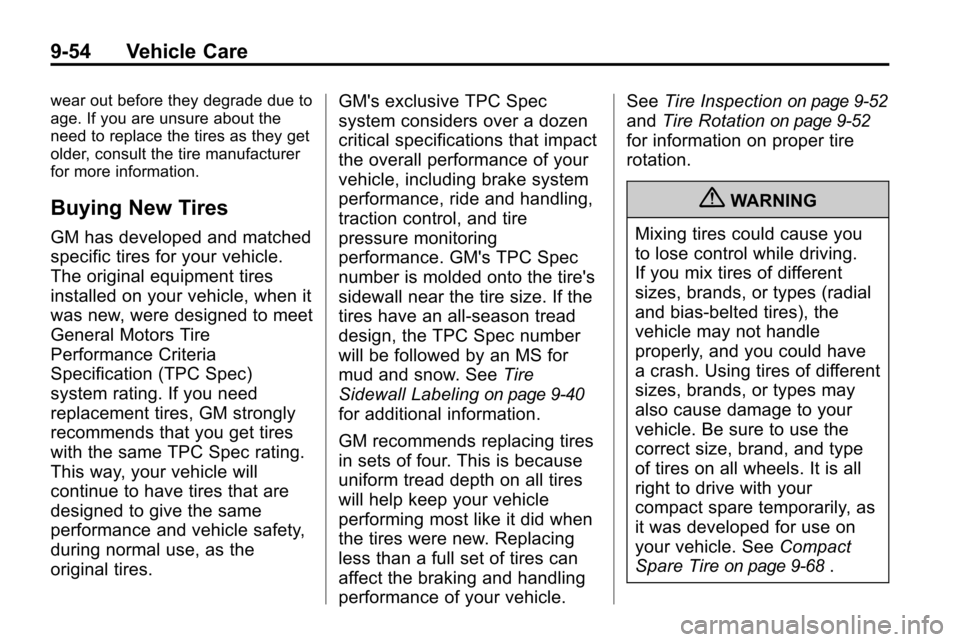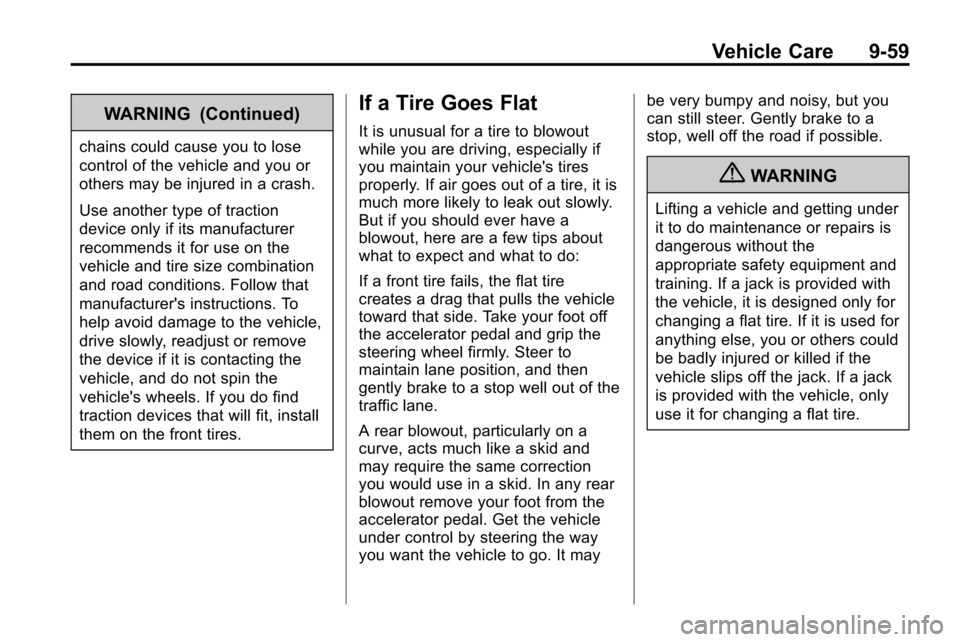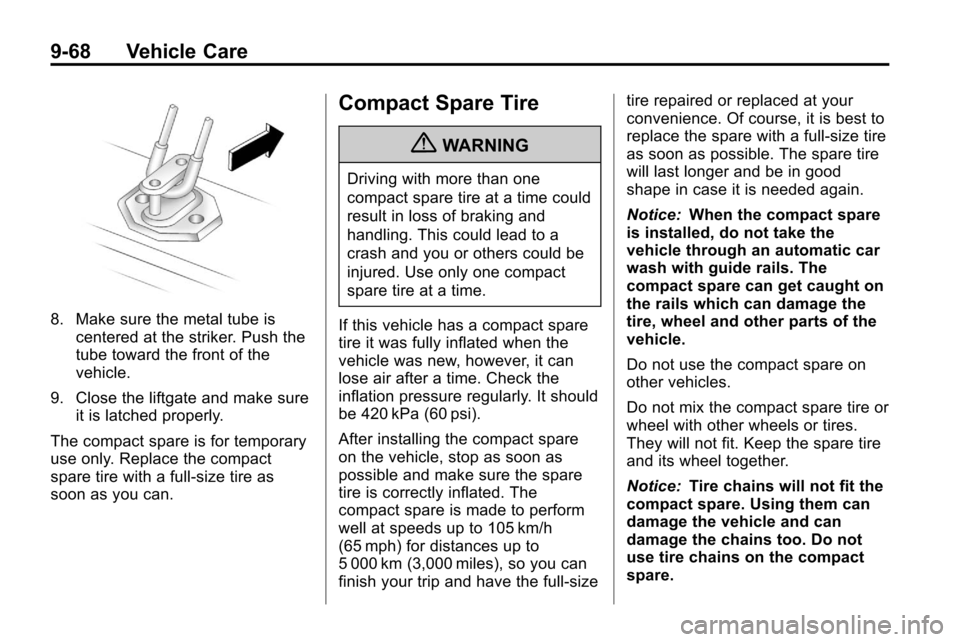2010 CHEVROLET EQUINOX wheel size
[x] Cancel search: wheel sizePage 322 of 394

9-54 Vehicle Care
wear out before they degrade due to
age. If you are unsure about the
need to replace the tires as they get
older, consult the tire manufacturer
for more information.
Buying New Tires
GM has developed and matched
specific tires for your vehicle.
The original equipment tires
installed on your vehicle, when it
was new, were designed to meet
General Motors Tire
Performance Criteria
Specification (TPC Spec)
system rating. If you need
replacement tires, GM strongly
recommends that you get tires
with the same TPC Spec rating.
This way, your vehicle will
continue to have tires that are
designed to give the same
performance and vehicle safety,
during normal use, as the
original tires.GM's exclusive TPC Spec
system considers over a dozen
critical specifications that impact
the overall performance of your
vehicle, including brake system
performance, ride and handling,
traction control, and tire
pressure monitoring
performance. GM's TPC Spec
number is molded onto the tire's
sidewall near the tire size. If the
tires have an all‐season tread
design, the TPC Spec number
will be followed by an MS for
mud and snow. See
Tire
Sidewall Labeling
on page 9‑40
for additional information.
GM recommends replacing tires
in sets of four. This is because
uniform tread depth on all tires
will help keep your vehicle
performing most like it did when
the tires were new. Replacing
less than a full set of tires can
affect the braking and handling
performance of your vehicle. See
Tire Inspection
on page 9‑52
andTire Rotationon page 9‑52
for information on proper tire
rotation.
{WARNING
Mixing tires could cause you
to lose control while driving.
If you mix tires of different
sizes, brands, or types (radial
and bias-belted tires), the
vehicle may not handle
properly, and you could have
a crash. Using tires of different
sizes, brands, or types may
also cause damage to your
vehicle. Be sure to use the
correct size, brand, and type
of tires on all wheels. It is all
right to drive with your
compact spare temporarily, as
it was developed for use on
your vehicle. See Compact
Spare Tire
on page 9‑68.
Page 323 of 394

Vehicle Care 9-55
{WARNING
If you use bias-ply tires on the
vehicle, the wheel rim flanges
could develop cracks after
many miles of driving. A tire
and/or wheel could fail
suddenly, causing a crash.
Use only radial-ply tires with
the wheels on the vehicle.
If you must replace your
vehicle's tires with those that do
not have a TPC Spec number,
make sure they are the same
size, load range, speed rating,
and construction type (radial and
bias‐belted tires) as your
vehicle's original tires.
Vehicles that have a tire
pressure monitoring system
could give an inaccurate
low‐pressure warning if
non‐TPC Spec rated tires are
installed on your vehicle. Non‐TPC Spec rated tires may
give a low‐pressure warning that
is higher or lower than the
proper warning level you would
get with TPC Spec rated tires.
See
Tire Pressure Monitor
System
on page 9‑47.
Your vehicle's original
equipment tires are listed on the
Tire and Loading Information
Label. See Vehicle Load Limits
on page 8‑24, for more
information about the Tire and
Loading Information Label and
its location on your vehicle.
Different Size Tires and
Wheels
If you add wheels or tires that are a
different size than your original
equipment wheels and tires, this
could affect the way your vehicle
performs, including its braking, ride
and handling characteristics,
stability, and resistance to rollover. Additionally, if your vehicle has
electronic systems such as anti‐lock
brakes, rollover airbags, traction
control, and electronic stability
control, the performance of these
systems can be affected.
{WARNING
If you add different sized wheels,
your vehicle may not provide an
acceptable level of performance
and safety if tires not
recommended for those wheels
are selected. You may increase
the chance that you will crash and
suffer serious injury. Only use GM
specific wheel and tire systems
developed for your vehicle, and
have them properly installed by a
GM certified technician.
See Buying New Tires
on
page 9‑54and Accessories and
Modificationson page 9‑4for
additional information.
Page 327 of 394

Vehicle Care 9-59
WARNING (Continued)
chains could cause you to lose
control of the vehicle and you or
others may be injured in a crash.
Use another type of traction
device only if its manufacturer
recommends it for use on the
vehicle and tire size combination
and road conditions. Follow that
manufacturer's instructions. To
help avoid damage to the vehicle,
drive slowly, readjust or remove
the device if it is contacting the
vehicle, and do not spin the
vehicle's wheels. If you do find
traction devices that will fit, install
them on the front tires.
If a Tire Goes Flat
It is unusual for a tire to blowout
while you are driving, especially if
you maintain your vehicle's tires
properly. If air goes out of a tire, it is
much more likely to leak out slowly.
But if you should ever have a
blowout, here are a few tips about
what to expect and what to do:
If a front tire fails, the flat tire
creates a drag that pulls the vehicle
toward that side. Take your foot off
the accelerator pedal and grip the
steering wheel firmly. Steer to
maintain lane position, and then
gently brake to a stop well out of the
traffic lane.
A rear blowout, particularly on a
curve, acts much like a skid and
may require the same correction
you would use in a skid. In any rear
blowout remove your foot from the
accelerator pedal. Get the vehicle
under control by steering the way
you want the vehicle to go. It maybe very bumpy and noisy, but you
can still steer. Gently brake to a
stop, well off the road if possible.
{WARNING
Lifting a vehicle and getting under
it to do maintenance or repairs is
dangerous without the
appropriate safety equipment and
training. If a jack is provided with
the vehicle, it is designed only for
changing a flat tire. If it is used for
anything else, you or others could
be badly injured or killed if the
vehicle slips off the jack. If a jack
is provided with the vehicle, only
use it for changing a flat tire.
Page 334 of 394

9-66 Vehicle Care
{WARNING
Wheel nuts that are improperly or
incorrectly tightened can cause
the wheels to become loose or
come off. The wheel nuts should
be tightened with a torque wrench
to the proper torque specification
after replacing. Follow the torque
specification supplied by the
aftermarket manufacturer when
using accessory locking wheel
nuts. SeeCapacities and
Specifications
on page 11‑2for
original equipment wheel nut
torque specifications.
Notice: Improperly tightened
wheel nuts can lead to brake
pulsation and rotor damage. To
avoid expensive brake repairs,
evenly tighten the wheel nuts in
the proper sequence and to the
proper torque specification. See
Capacities and Specifications
on
page 11‑2for the wheel nut
torque specification.
18. Tighten the wheel nuts firmly in a crisscross sequence, as
shown.
19. Lower the jack all the way and remove the jack from under the
vehicle.
20. Tighten the wheel nuts firmly with the wheel wrench.
When reinstalling the wheel cover or
center cap on the full-size tire,
tighten all five plastic caps hand
snug with the aid of the wheel
wrench and tighten them with the
wheel wrench an additional one‐
quarter of a turn. Notice:
Wheel covers will not fit
on your vehicle's compact spare.
If you try to put a wheel cover on
the compact spare, the cover or
the spare could be damaged.
Storing a Flat or Spare Tire
and Tools
{WARNING
Storing a jack, a tire, or other
equipment in the passenger
compartment of the vehicle could
cause injury. In a sudden stop or
collision, loose equipment could
strike someone. Store all these in
the proper place.
Page 336 of 394

9-68 Vehicle Care
8. Make sure the metal tube iscentered at the striker. Push the
tube toward the front of the
vehicle.
9. Close the liftgate and make sure it is latched properly.
The compact spare is for temporary
use only. Replace the compact
spare tire with a full-size tire as
soon as you can.
Compact Spare Tire
{WARNING
Driving with more than one
compact spare tire at a time could
result in loss of braking and
handling. This could lead to a
crash and you or others could be
injured. Use only one compact
spare tire at a time.
If this vehicle has a compact spare
tire it was fully inflated when the
vehicle was new, however, it can
lose air after a time. Check the
inflation pressure regularly. It should
be 420 kPa (60 psi).
After installing the compact spare
on the vehicle, stop as soon as
possible and make sure the spare
tire is correctly inflated. The
compact spare is made to perform
well at speeds up to 105 km/h
(65 mph) for distances up to
5 000 km (3,000 miles), so you can
finish your trip and have the full-size tire repaired or replaced at your
convenience. Of course, it is best to
replace the spare with a full-size tire
as soon as possible. The spare tire
will last longer and be in good
shape in case it is needed again.
Notice:
When the compact spare
is installed, do not take the
vehicle through an automatic car
wash with guide rails. The
compact spare can get caught on
the rails which can damage the
tire, wheel and other parts of the
vehicle.
Do not use the compact spare on
other vehicles.
Do not mix the compact spare tire or
wheel with other wheels or tires.
They will not fit. Keep the spare tire
and its wheel together.
Notice: Tire chains will not fit the
compact spare. Using them can
damage the vehicle and can
damage the chains too. Do not
use tire chains on the compact
spare.
Page 342 of 394

9-74 Vehicle Care
Once the destination has been
reached:
1. Set the parking brake.
2. Shift the transmission toP (Park).
3. Turn the ignition key to LOCK/OFF.
4. Install fuse 32, the Discrete Logic Ignition Switch fuse. See
Instrument Panel Fuse Block
on
page 9‑37.
5. Start the engine and let it idle for more than three minutes before
driving the vehicle.
Notice: Too much or too little
fluid can damage the
transmission. Be sure that the
transmission fluid is at the proper
level before towing with all four
wheels on the ground. Notice:
Do not tow a vehicle with
the front drive wheels on the
ground if one of the front tires is
a compact spare tire. Towing with
two different tire sizes on the
front of the vehicle can cause
severe damage to the
transmission.
Dolly Towing (All-Wheel‐Drive
Vehicles)
All-wheel‐drive vehicles should not
be towed with two wheels on the
ground. To properly tow these
vehicles, they should be placed on
a platform trailer with all four wheels
off of the ground or dinghy towed
from the front.
Dolly Towing
(Front-Wheel‐ Drive Vehicles)
To tow the vehicle from the front
with the rear wheels on the ground,
do the following:
1. Put the front wheels on a dolly.
2. Move the shift lever to P (Park).
3. Set the parking brake.
Page 393 of 394

INDEX i-11
T
Tachometer . . . . . . . . . . . . . . . . . . . . 4-13
TaillampsBulb Replacement . . . . . . . . . . . . 9-32
Text Telephone (TTY) Users . . . 12-4
Theft-Deterrent Systems . . . . . . . 1-13 Immobilizer . . . . . . . . . . . . . . . . . . . 1-13
Time . . . . . . . . . . . . . . . . . . . . . . 4-9, 4-10
Tires Buying New Tires . . . . . . . . . . . . . 9-54
Chains . . . . . . . . . . . . . . . . . . . . . . . . 9-58
Changing . . . . . . . . . . . . . . . . . . . . . 9-61
Compact Spare . . . . . . . . . . . . . . . 9-68
Designations . . . . . . . . . . . . . . . . . 9-42
Different Size . . . . . . . . . . . . . . . . . 9-55
If a Tire Goes Flat . . . . . . . . . . . . 9-59
Inflation Monitor System . . . . . . 9-49
Inspection . . . . . . . . . . . . . . . . . . . . 9-52
Messages . . . . . . . . . . . . . . . . . . . . 4-33
Pressure Light . . . . . . . . . . . . . . . . 4-21 Tires (cont.)
Pressure Monitor System . . . . . 9-47
Rotation . . . . . . . . . . . . . . . . . . . . . . 9-52
Sidewall Labeling . . . . . . . . . . . . . 9-40
Terminology and
Definitions . . . . . . . . . . . . . . . . . . . 9-43
Uniform Tire Quality Grading . . . . . . . . . . . . . . . . . . . . . 9-56
Wheel Alignment and Tire
Balance . . . . . . . . . . . . . . . . . . . . . 9-57
Wheel Replacement . . . . . . . . . . 9-57
When It Is Time for New Tires . . . . . . . . . . . . . . . . . . . . . . . . 9-53
Towing
Driving Characteristics . . . . . . . . 8-58
Equipment . . . . . . . . . . . . . . . . . . . . 8-63
General Information . . . . . . . . . . 8-57
Recreational Vehicle . . . . . . . . . . 9-72
Trailer . . . . . . . . . . . . . . . . . . . . . . . . 8-61
Trailer Sway Control (TSC) . . . 8-64
Vehicle . . . . . . . . . . . . . . . . . . . . . . . 9-72 Traction
Control System (TCS) . . . . . . . . 8-41
Control System (TCS)/
StabiliTrak
®Light . . . . . . . . . . . . 4-21
Off Light . . . . . . . . . . . . . . . . . . . . . . 4-20
Trailer Sway Control (TSC) . . . . . . . . . . 8-64
Trailer Towing . . . . . . . . . . . . . . . . . 8-61
Transmission Automatic . . . . . . . . . . . . . . . . . . . . . 8-35
Fluid, Automatic . . . . . . . . . . . . . . 9-12
Messages . . . . . . . . . . . . . . . . . . . . 4-33
Transportation Program, Courtesy . . . . . . . . . . . . . . . . . . . . . 12-8
Turn and Lane-Change Signals . . . . . . . . . . . . . . . . . . . . . . . . 5-3
Turn Signal Bulb Replacement . . . . . . . . . . . . 9-32
Page 394 of 394

i-12 INDEX
U
Ultrasonic Parking Assist . . . . . . 8-46
Uniform Tire QualityGrading . . . . . . . . . . . . . . . . . . . . . . 9-56
Using this Manual . . . . . . . . . . . . . . . . iv
V
Vehicle Canadian Owners . . . . . . . . . . . . . . .iv
Control . . . . . . . . . . . . . . . . . . . . . . . . 8-4
Load Limits . . . . . . . . . . . . . . . . . . . 8-24
Messages . . . . . . . . . . . . . . . . . . . . 4-27
Personalization . . . . . . . . . . . . . . . 4-34
Remote Start . . . . . . . . . . . . . . . . . . 1-5
Security . . . . . . . . . . . . . . . . . . . . . . 1-12
Towing . . . . . . . . . . . . . . . . . . . . . . . . 9-72
Vehicle Care Tire Pressure . . . . . . . . . . . . . . . . . 9-46 Vehicle Identification
Number (VIN) . . . . . . . . . . . . . . . . . 11-1
Service Parts Identification
Label . . . . . . . . . . . . . . . . . . . . . . . . 11-1
Vehicle Reminder Messages . . . . . . . . . . . . . . . . . . . . 4-34
Ventilation, Air . . . . . . . . . . . . . . . . . . 7-6
Visors . . . . . . . . . . . . . . . . . . . . . . . . . 1-18
W
Warning Lights, Gauges,
and Indicators . . . . . . . . . . . . . . . . 4-11
Warnings . . . . . . . . . . . . . . . . . . . . . . . . . iv
Cautions and Danger . . . . . . . . . . . .iv
Hazard Flashers . . . . . . . . . . . . . . . 5-2
Washer Fluid . . . . . . . . . . . . . . . . . . 9-21 Wheels
Alignment and Tire
Balance . . . . . . . . . . . . . . . . . . . . . 9-57
Different Size . . . . . . . . . . . . . . . . . 9-55
Replacement . . . . . . . . . . . . . . . . . 9-57
When It Is Time for New Tires . . . . . . . . . . . . . . . . . . . . . . . . . 9-53
Where to Put the Child Restraint . . . . . . . . . . . . . . . . . . . . . 2-43
Windows . . . . . . . . . . . . . . . . . . . . . . 1-16 Power . . . . . . . . . . . . . . . . . . . . . . . . 1-16
Windshield Wiper/Washer . . . . . . . . . . . . . . . . . 4-7
Winter Driving . . . . . . . . . . . . . . . . . 8-21
Wiper Blade Replacement . . . . . 9-26
Wipers Rear Washer . . . . . . . . . . . . . . . . . . 4-8